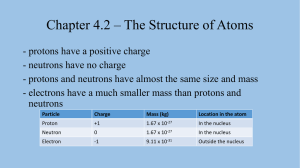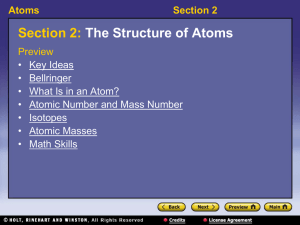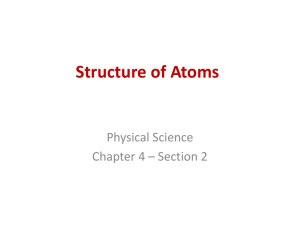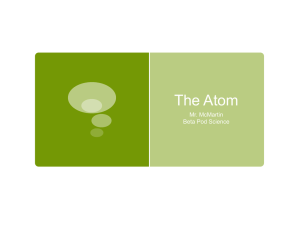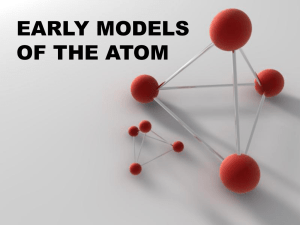Chapter 4: ATOMS
advertisement
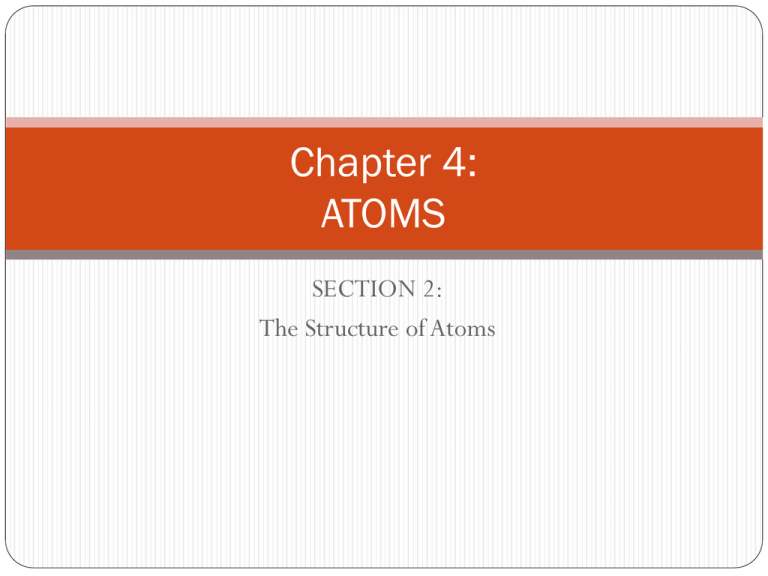
Chapter 4: ATOMS SECTION 2: The Structure of Atoms Bellringer Atoms are very small, and they are made up of even smaller subatomic particles. You will have 3 minutes to answer these 3 questions: Bellringer 1. In the diagram, A is the center of an atom. What is the center of an atom called? Nucleus 2. The center of an atom is made up of positively charged particles and particles that have no electrical charge. Name the two particles. Protons and Neutrons 3. Negatively charged electrons are found in clouds outside the center of an atom. Why are electrons attracted to the center of the atom? Electrons have a negative charge, nucleus has a positive charge. Open your books to page 119 What is in an Atom? An atom is the smallest unit of an element that maintains the chemical properties of that element. Each element has a unique number of protons. Unreacted atoms have no overall charge. Because there is an equal number of protons and electrons, the charges cancel out. The electric force holds the atom together. Positive protons are attracted to negative electrons by the electric force. Atomic Number and Mass Number 〉What do atoms of an element have in common with other atoms of the same element? Atoms of each element have the same number of protons, but they can have different numbers of neutrons. Atomic Number and Mass Number, continued The atomic number equals the number of protons. atomic number: the number of protons in the nucleus of an atom The mass number equals the total number of subatomic particles in the nucleus. mass number: the sum of the numbers of protons and neutrons in the nucleus of an atom Atomic Number and Mass Number, continued Isotopes 〉Why do isotopes of the same element have different atomic masses? 〉Isotopes of an element vary in mass because their numbers of neutrons differ. Isotopes, continued Isotopes, continued Some isotopes are more common than others. radioisotopes: unstable isotopes that emit radiation and decay into other isotopes The number of neutrons can be calculated. number of neutrons = mass number – atomic number Atomic Masses 〉What unit is used to express atomic mass? 〉Because working with such tiny masses is difficult, atomic masses are usually expressed in unified atomic mass units. unified atomic mass unit: a unit of mass that describes the mass of an atom or molecule; it is exactly 1/12 the mass of a carbon atom with mass number 12 (symbol, u) Atomic Masses, continued The mole is useful for counting small particles. mole: the SI base unit used to measure the amount of a substance whose number of particles is the same as the number of atoms of carbon in exactly 12 g of carbon-12 (abbreviation, mol) 1 mol = 602, 213, 670, 000, 000, 000, 000, 000 particles This number, usually written as 6.022 × 1023, is called Avogadro’s number. Visual Concept: The Mole Visual Concept: Avogadro’s Number Atomic Masses, continued Moles and grams are related. molar mass = the mass in grams of one mole of a substance Example: 1 mol of carbon-12 atoms has a mass of 12.00 g, so the molar mass of carbon-12 is 12.00 g/mol You can convert between moles and grams. Math Skills Converting Moles to Grams Determine the mass in grams of 5.50 mol of iron. 1. List the given and unknown values. Given: amount of iron = 5.50 mol Fe molar mass of iron = 55.84 g/mol Fe* Unknown: mass of iron = ? g Fe *Use the periodic table to find molar masses. The average atomic mass of an element is equal to the molar mass of the element. This book rounds values to the hundredths place. Math Skills, continued 2. Write down the conversion factor that converts moles to grams. The conversion factor you choose should have what you are trying to find (grams of Fe) in the numerator and what you want to cancel (moles of Fe) in the denominator. 3. Multiply the amount of iron by this conversion factor, and solve. Atomic Masses, continued Compounds also have molar masses. To find the molar mass of a compound, add up the molar masses of all of the atoms in a molecule of the compound. Example: finding the molar mass of water, H2O molar mass of O = 16.00 g/mol molar mass of H = 1.01 g/mol molar mass of H2O = (2 × 1.01 g/mol) + 16.00 g/mol = 18.02 g/mol



